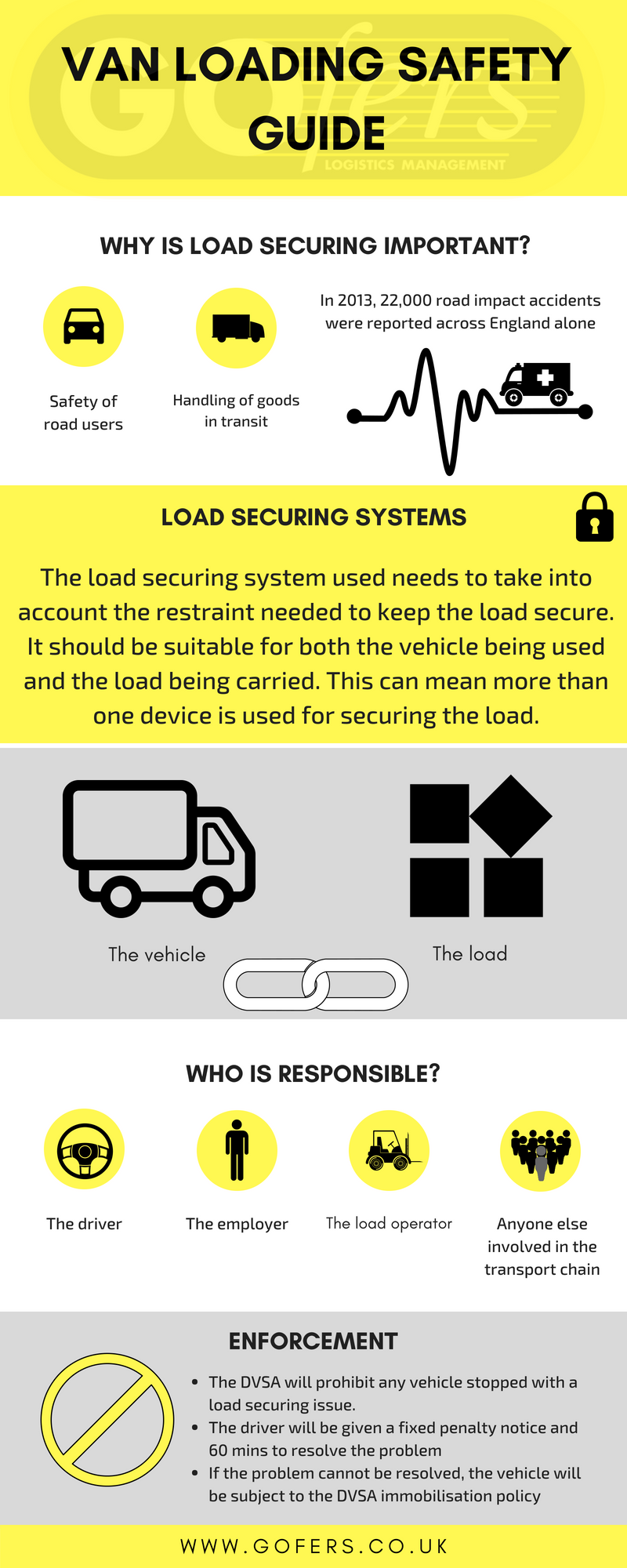
Loading a van safely is not only beneficial for the operator, but also a legal requirement for driving on the UK roads. A secure load is a primary concern that impacts the safety all road users and as such is subject to guidance and legalities from the DVSA, DfT and the EC, amongst others. Operators, consignors and drivers all have their own responsibilities with regards to van loading that must be met.
Why is Load Securing Important?
An insecure load can pose a significant risk on the road; there have been many reports of accidents, injuries and fatalities on the roads caused by insecure loads.
- In 2013, 22,000 road impact incidents were reported across England alone, caused by objects falling from vehicles in transit.
- One such example is that of the death of a car passenger in Northamptonshire in 2009, who was killed by a six-foot fencing panel that had become dislodged from the roof of a van in front and went through the window of the car, seriously injuring him. He later died in hospital. The driver of the van was jailed for 28 months and received a 2-year driving ban.
Load Securing Systems
It is important to ensure the load securing system(s) being sued are suitable for both:
- The vehicle being used
- The load being carried
The securing method should be chosen to fit the vehicle being used. Whilst there are common methods such as webbing straps or chains, these may not suit every vehicle or situation. Fragile loads may need especial care.
The securing method/restraint system used should also take into account the restraint needed to keep the load secure. More force will be required to secure it in motion (dynamic) than when stationary (static). It must be sufficient to withstand a forwards force not less than the total weight of the load to prevent the load moving under severe braking, and half the weight of the load moving backwards and sideways.
Who is Responsible?
The driver is the one primarily responsible for the vehicle and any load being carried, but he is not the only person responsible. This lies with everyone included in the transport chain of any given load, including employers and load operators.
Risk assessments are a legal requirement and should be taken to identify any potential issues before the vehicle leaves. This must include guidelines for the driver to follow if the load shifts in transit, as drivers should not be expected to deal with an unsafe load alone at the roadside. Any load shifts should be reported by the driver to avoid such incidents happening again.
Driver(s)
The driver(s) needs to ensure they are using a suitable vehicle for the load being carried, and that it is loaded safely for transport on the road.
The driver also needs to ensure that communication is open and clear between both supplier and delivery site to prevent against any issues arising, and remedial action taken on any that do arise before bigger problems happen.
There are a set of questions that the driver should ask themselves before setting off. These are used by the DVSA to determine load safety, so if the answer to any question is negative, this would be the same view as shared by the DVSA.
These are:
- can the load slide or topple forwards or backwards?
- can the load slide or topple off the side?
- is the load unstable?
- is the load securing equipment in poor condition?
- is there anything loose that might fall off?
- does the vehicle present an immediate likelihood of causing danger of injury due to its load security or stability?
Load operators
Load operators are responsible for ensuring the load remains in a safe condition throughout the whole operation, from initial loading to final unloading at the end destination. Whilst drivers should be involved in the loading operation, if this is not possible they should be given the opportunity to observe the vehicle being loaded, or at least full information about how the load is secured and the chance to check it before departing.
Loading plans are useful and used by many – these ensure good communication between the driver and delivery site and outline responsibilities for all involved. A loading plan will include how the load should be unloaded and what happens if there are any shifts in transit.
Enforcement
There are two laws which are currently used by the DVSA with regards to load securing; these are:
- The Road Vehicles (Construction and Use) Regulations 1986, regulation 100
- The Road Traffic Act 1988, section 40a
If a vehicle is stopped and found to have a load securing problem, a prohibition will be issued that prevents the vehicle from being moved until the problem is resolved.
The driver will be given a fixed penalty notice and 60 minutes to fix the problem. If this is not possible, then the vehicle will be subject to the DVSA immobilisation policy, which then has a release fee of £80 (payable by the operator, not the driver).
The driver may also be subject to penalty points, but this is not a routine procedure. The DVSA can also start legal proceedings and a report to the Traffic Commissioner, depending on how serious the problem is. This in turn can lead to the suspension of the driver’s vocational license.








